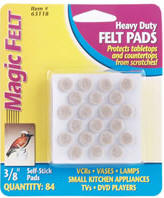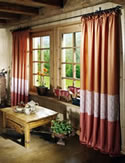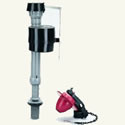The most common incidents are where holes have been made to allow for the installation of pipes and conduit. These holes provide gaps where sound waves can travel. Drain pipes from bathtubs, and kitchen and bathroom sinks should be sealed.

Figure 1 - Expanding foam

Figure 2 - Water pipe insulation

Figure 3 - Felt pads

Figure 4 - Foam weather strip
Sealing these holes can be accomplished using silicone caulking, if the area to be sealed is less than 1/4 inch or expanding foam (Figure 1) if the hole to be filled is large. This and similar expanding foam products not only reduce noise but add insulation. By plugging a hole you are also eliminating the movement of hot and cold air between rooms. In the case of a bathroom you are keeping the moisture in the room and not allowing it to enter the cavities between the wall studs or floor joists.
Water pipes make noise in a couple of different manners.
- Water hammering can occur if the water pressure has no where to go when a faucet or tap is turned off.
- There is also the sound of the water travelling through the pipes. A lot of this noise can be eliminated by insulating the pipes with foam, as shown in Figure 2. These foam split tubes are easy to install even as a retrofit. Not only will they reduce noise but they will contain the heat in the hot water pipes, saving you energy.
Eliminating water hammering is covered in another section.
Another annoying noise that is common in homes are interior doors that rattle when closed. This rattling is usually caused when windows are open and air is attempting to escape the room.
This problem can be fixed easily by applying small, self-stick felt, cork or foam pads (Figure 3) on the top and bottom of the door stop. Not only will this reduce the noise from rattling doors, but it will all but eliminate the noise created by doors slamming shut. These also work well for cupboard and closet doors.
You can use foam weather stripping (Figure 4) to seal exterior doors and windows that rattle. Foam weather stripping can also be used on interior doors, however I do not believe that the aesthetics are as acceptable as the felt, cork or foam pads.
If you have a quantity of noise exiting a room, even when the door is closed, it is most likely that the noise is emanating from the area between the bottom of the door and the floor. Where rooms are carpeted this noise is reduced, however if the room has hardwood, laminate or other solid flooring material you can seal the bottom of the door by adding a narrow strip of carpeting to the bottom of the door (not the floor).
Cut a strip of carpeting about 1 1/2 inches wide and the same width as the door. Remove the door and using carpet tacks or a staple gun fix the strip of carpeting to the bottom of the door. A thick pile such as shag works best.

Figure 5 - Drapes can provide sound reduction

Figure 6 - Silent toilet tank fill valve assembly
Note: Sealing a specific room can have a detrimental effect on air circulation, heating and cooling through-out the entire home or a specific room or area.
Within a room, drapes (Figure 5) work better than any other material for sound reduction, both internally generated sound and sound coming from outside your home. Drapes also provide the best insulation, with respect to window decor, then any other window treatments such as window shades, blinds and shutters.
Installing full length, floor to ceiling cloth drapes will have a dramatic effect on the sound transmission within a room. They not only block sound, but they absorb sound waves.
Additional information on drapes
If the flushing of toilets can be heard throughout your home you can change the fill valves (Figure 6) in the toilet tanks to units that do not make any noise when filling.
The replacement of the fill valve is an easy repair for any home handyman.
Additional information on the replacement of the fill valve in a toilet tank.
The toilet tank water inlet valve should always be fully open. Valves that are partially open will create noise as the water travels through the valve.
